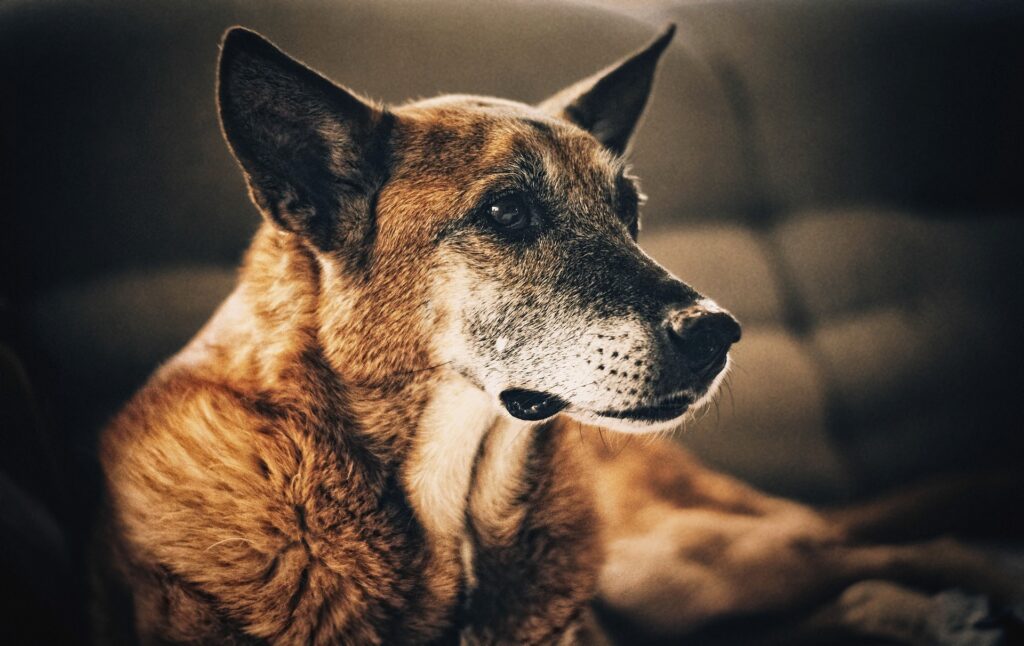Dr. Gemma Schreiner: A vet, who employs a holistic approach to age-related challenges, specialises in palliative care for elderly companion animals.
The dog’s nails tap on the wooden floor like a River dancer and the child squeals in delight. The happy sounds float into a sombre room, a couple bows over a table crooning words of love. The vet empties the syringe and everything is peacefully still.
Gemma arrives at the café and smiles brightly when I catch her eye. With her two gorgeous blondies in tow (3-year-old Gracie and 18-month-old Jack) she has just come from her last appointment at the clinic.
“Thanks so much for meeting with me,” I say, “I know your free time is precious. How did it go?”
“Usually, not too bad, but this one was really sad.”
We agreed to meet at a local kid-friendly spot so that Gracie and Jack could play. They need no encouragement to take ownership of their afternoon’s entertainment while we talk about Gemma’s work.
In a departure from my usual articles that focus on vet nurse knowledge, I am inspired by Gemma’s chosen path. I feel that anyone who believes that the elderly (human or animal) deserve our respect and care should be celebrated. People like Gemma create light in the world and, as far as I’m concerned, their opinions count.
Gemma was born near Liverpool in the UK. Shortly after graduating from Cambridge University in 2011, she moved to South Africa. After working in a busy welfare clinic and an even busier emergency clinic, she undertook a course with the International Association for Animal Hospice and Palliative Care (IAAHPC) in 2018. She founded Companion Animal Comfort Care and currently operates in the Western Cape. When I asked what inspired her to work with elderly animals, I was expecting a dramatic, life-changing tale.
On the contrary — the way various human cultures treat their aged has always interested her. Despite, and perhaps because of our shortcomings as a species, she felt motivated to provide specialised aged care in her field of expertise.
Some cultures revere wisdom and old age, some keep their elderly family members close to protect them. In Western society, however, we tend to treat ageing as a disease. We often don’t have time for their needs. We send them to facilities; inflicting isolation and loneliness instead of family and inclusivity.
Gemma recalls an inspirational book, Being Mortal by the surgeon and writer, Atul Gawande (I downloaded it from Audible after our meeting). In the author’s summary, Gawande writes, “The ultimate goal, after all, is not a good death, but a good life – all the way to the very end.” In light of how his narrative relates to our pets, I believe that I am beginning to understand Gemma’s motivation.
We don’t send our pets to care homes when they are old, but we do lack understanding of the ageing process. Gemma’s passion is to educate her clients and provide holistic support for both so that when that dreaded day arrives, the final journey has been celebrated and the end is filled with peace, dignity and acceptance.

The most common challenges facing old pets
As your pet enters the winter of life, physiological systems collectively begin to decline.
The body’s systems are interlinked; they rely on each other. If one loses function, others soon start to suffer. Gawande likens the body to a mechanical system with backup support: The mammalian body can make use of its own backup system — a second kidney or regenerating liver cells. But even these reservoirs become exhausted and then the downhill slide to mortality becomes more challenging.
To fully comprehend the challenges that Gemma faces we need to understand the difference between terminal (also called hospice or comfort) and palliative care. Palliative care can provide for both terminal and non-terminal situations. Gemma describes palliation as a holistic approach that seeks to boost the quality of life from physical to social and emotional whilst curative solutions may still be an option. Hospice care implies that a pet’s condition is ultimately fatal and as such treatment is only aimed at maximising quality of life.
I ask Gemma about the most common problems that her elderly patients experience.
PAIN
Gemma spends a large portion of her time managing pain when it is understood that certain conditions are irreversible and the patient will never be fully freed from it.
Pain is a symptom of many diseases but its management in an elderly pet poses a unique set of challenges. Certain types of pain medication can negatively affect other non-target systems. The ageing liver has to work harder to metabolise chemicals in the bloodstream. Some analgesics can even affect the efficacy of other drugs that are required to manage certain disorders.
An American vet (Dr. Alice Villalobos) started a quality-of-life programme for terminal pets in the 1970s and called it Pawspice (akin to human Hospice) care. She created a scale that measures seven concepts to assess the quality of life. They are hurt, hunger, hydration, hygiene, happiness, mobility and ‘more good days than bad’, where each is afforded a score from 1 to 10. An overall score below 35 indicates an unacceptable quality of life. Amongst other techniques like pain scoring scales, Gemma finds this an invaluable tool. For what is an understandably traumatic period for pet owners, the scoring sheets and scales provide a seemingly objective and emotionless evaluation in black and white which often helps to clarify what their pets are experiencing without subjectivity.
Using her holistic approach, Gemma networks with like-minded healers, from behaviourists to acupuncture specialists and physiotherapists.
CANCER
Although it affects pets of all ages, cancer is a common disorder in elderly pets. It is defined as the uncontrolled division of damaged or abnormal cells. It is more prevalent in older pets due simply to accumulated damage of cell machinery over time.
Cancer can grow slowly or rapidly. It can be benign or dangerous. It can remain localised or spread rapidly through the body. In the case of more aggressive cancers, death occurs due to physical impediments of vital systems due to rapidly dividing cells.
If cancer is suspected, there are options available to pet owners (laboratory tests or scans) to identify the type. This information is vital to help Gemma educate her clients and prepare them for the specific challenges ahead.
CHRONIC DISEASES
Wear and tear — the overarching cause of decay.
Chronic diseases are caused by systems that are wearing out and no longer functioning at 100% efficiency. Organs like the heart, lungs, liver, spleen and kidneys don’t clock out; they work constantly to maintain the system.
Take for example chronic kidney disease in ageing pets: Two plump little bags that spend every second of their existence cleaning the blood. Made up of about half a million tiny filtering units called nephrons, a dog’s kidneys filter waste, balance electrolytes, maintain hydration and produce hormones that do a multitude of other essential tasks too. The problem is, once a nephron is worn out, it cannot be fixed. With every dying nephron, kidney function is reduced and complete kidney failure creeps closer. The many symptoms of failing kidneys are a testament to the myriad processes that the kidneys support.
Chronic heart disease can also be blamed on a muscle that is wearing out. In a perfectly choreographed dance, the heart allows blood in and sends it away in perfect balance. Valves ensure the flow is regular and constant, but these too can eventually become tired and wear out.
Another example of chronic disease caused by wear and tear is seen in the endocrine system. There are eight different hormone-producing endocrine glands in your pet’s body and some are paired. Hormones control biological processes including, but not limited to, growth and development, metabolism, reproduction, glucose and water balance.
The process of glucose management also occurs in one form of diabetes. The ageing endocrine gland —the pancreas — ceases to produce sufficient insulin to transform glucose into energy to drive muscles. Cushing’s disease (another endocrine disease caused by an overproduction of cortisol) can be caused by a cancerous tumour on an adrenal gland and hypothyroidism (an underactive thyroid gland) causes a myriad of symptoms.
These examples only touch on enormously complicated systems that work together to form the amazing creature that is your pet, but they serve to illustrate that, as one function diminishes with age, every single process in the body is affected.
CREAKY OLD JOINTS
Mobility is another common problem for elderly pets. Calcium (one of the most important macro minerals) is used in so many processes that it’s not surprising the bones are hit hard by the ravages of time. Calcium is required for muscle and nerve function, it helps insulin to convert sugar into glucose and energy, it is depleted by the overproduction of a hormone in the adrenal glands and it is constantly demanded by the body’s cells for normal functioning. It is leached from bones causing them to become more fragile in old age.
Just a worn-down joint that has carried a body around for years can cause pain and discomfort to an ageing pet. Flexibility wanes and basic movements like scratching behind the ear can become a painful undertaking.
APPETITE
I ask Gemma to comment on food as it relates to older animals. Feeding your old pets too much food can create an unhealthy and even painful cycle. As movement becomes more difficult and the pet becomes more sedentary, boredom encourages eating. As the pet eats more to stave off boredom, the joints have to carry more weight and become more painful.
This is one aspect of feeding older pets but Gemma also experiences the other aspect. Often aged pets do not have an appetite. With a reduction in activity and thus metabolism, older animals don’t need as much energy from food. Energy is no longer required to build muscles or bones. Gemma recalls her own beloved dog that ate less and less when he was on his final journey. She remembers the feeling of desperation that so many owners experience at their sick pet not wanting to eat and having to accept this was part of the process. The truth is that the elderly do not need as much energy from their food and they should be permitted to eat what they want (within reason of course) without being forced.
THIS IS THE END
Old age doesn’t only come with health complications. The dreaded question about the end looms over every person who loves their pet – when is the right time?
I want to talk about death. As a nurse, I have experienced situations where owners do not want to let go at the end. At times it seemed clear that the pet was suffering and that euthanasia would be the kindest option but the decision lay with the owner who, for whatever reason, was unable to make it and pushed to keep up treatment.
Gemma agrees that there is often untold emotional trauma associated with this specific part of the journey. She says that often clients are overcome with anguish in the very first consult (she calls it anticipatory grief) because the prospect of that final day is too much for them to bear — and the very reason they find themselves with a palliative care specialist.
In her initial consultation with new clients, Gemma makes sure that every element is discussed: the client’s needs, financial implications, treatment options, the ability of the client to provide specific care and even choices about euthanasia. With the aid of the quality-of-life scales and pain scoring methods, Gemma undertakes a guided conversation that allows clients to verbalise their expectations, needs and wants. She says that most clients want to know how they will know when the time has come and that’s because many people just don’t want their beloved family member to suffer.
Gemma will usually check in weekly or even daily with her clients — a brief chat or WhatsApp message allows her to see whether the journey is smooth or not. Gemma says that communication is a mainstay of the relationship and even allows clients to call her private number after hours in case a patient is getting worse.
COMPASSION DRAINER
There is a question that has been tugging on my ear ever since I decided to write this article. There’s a big white elephant sitting next to us at the table and I need to address it. I want to know how Gemma protects herself. By its nature, this path ends in death. It is tragic and heart-breaking. Gemma creates relationships with her clients and patients and the outcome is invariably sad. I ask her, “How do you cope with loss every single time? You provide so much support but who supports you?”
Gemma laughs at my dramatic approach. Her response is so different from anything I could have imagined: “Death comes to us all”, she says, “It’s going to happen.” She seeks to normalise the bumpy road, to empower her clients so that they feel more at ease because they understand what is happening. She provides personal support and assurances. She wants the end of days to be a positive and beautiful experience.
I suddenly recall the death of my father. His oncologist had been the voice of reason: the one we turned to when there were bad days, the advisor, the one who provided medicine, knowledge and ‘care’. On his deathbed, my father’s doctor was on holiday and could not be reached. My brother and I had nobody to confer with, nobody to assure us that the decision to terminate my father’s life by agreeing to stop the adrenalin was correct. The absence of that person made the experience more traumatic than I could have ever imagined.
Gemma supports her clients to the very end, often visiting the homes of her clients and patients to ease the trauma of travelling to the clinic. Often, her relationships with clients are maintained long after their pets have gone. She is not drained of compassion but buoyed by the fact that her presence and her passion have made something beautiful out of something that could be so tragic. By providing expert knowledge, reassurance and constant support, she is making the transition easier for those departing and those left behind.
I have euthenased many pets in my career. When owners are distraught, the pet is distraught. Your super-sensitive pet is part of your pack and is sad when you are sad. What better way to say farewell and cross the rainbow bridge than when everyone is together, crooning words of love, smiling and peaceful?
What could be a better farewell for someone so dear to us?
A special thanks to Dr. Gemma for her time and for allowing us to look at her world for a while.
https://www.companionanimalcomfortcare.com/
References
Gawande, A. (2019). Being Mortal. Profile Audio. https://www.audible.co.uk/pd/Being-Mortal-Audiobook
Copyright Liz Roodt 2023

